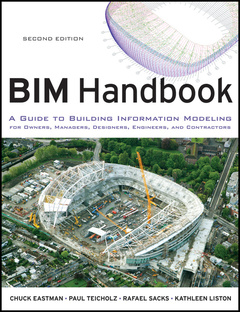Description
BIM handbook: a guide to building information modeling for owners, managers, designers, engineers and contractors (2nd Ed.)
Authors: EASTMAN Chuck, TEICHOLZ Paul, SACKS Rafael, LISTON Kathleen
Language: English
Subject for BIM handbook: a guide to building information modeling...:
Approximative price 80.19 €
In Print (Delivery period: 14 days).
Add to cart626 p. · Hardback
Description
/li>Contents
/li>
-AECbytes book review, August 28, 2008 ( BIM: A better way to build better buildings
Building Information Modeling (BIM) offers a novel approach to design, construction, and facility management in which a digital representation of the building process is used to facilitate the exchange and interoperability of information in digital format. BIM is beginning to change the way buildings look, the way they function, and the ways in which they are designed and built.
The BIM Handbook, Second Edition provides an in-depth understanding of BIM technologies, the business and organizational issues associated with its implementation, and the profound advantages that effective use of BIM can provide to all members of a project team. Updates to this edition include:
Completely updated material covering the current practice and technology in this fast-moving field
Expanded coverage of lean construction and its use of BIM, with special focus on Integrated Project Delivery throughout the book
New insight on the ways BIM facilitates sustainable building
New information on interoperability schemas and collaboration tools
Six new case studies
Painting a colorful and thorough picture of the state of the art in building information modeling, the BIM Handbook, Second Edition guides readers to successful implementations, helping them to avoid needless frustration and costs and take full advantage of this paradigm-shifting approach to construct better buildings that consume fewer materials and require less time, labor, and capital resources.
Preface.
Chapter 1 BIM Handbook Introduction.
1. 0 Executive Summary.
1.1 Introduction.
1.2 The Current AEC Business Model.
1.3 Documented Inefficiencies of Traditional Approaches.
1.4 BIM: New Tools and New Processes.
1.5 What Is Not BIM Technology.
1.6 What Are the Benefits of BIM? What Problems Does It Address?
1.7 What Challenges Can Be Expected?
1.8 Future of Designing and Building with BIM (Chapter 8).
1.9 Case Studies (Chapter 9).
Chapter1 Discussion Questions.
Chapter 2 BIM Design Tools and Parametric Modeling.
2.0 Executive Summary.
2.1 The Evolution to Object-based Parametric Modeling.
2.2 Parametric Modeling of Buildings.
2.3 Beyond Parametric Shapes.
2.4 BIM Environments, Platforms and Tools.
2.5 Overview of the Major BIM Design Platforms.
2.6 BIM Platforms.
2.7 Lightweight Modeling Applications.
2.8 Conclusion.
Chapter 2 Discussion Questions.
Chapter 3 Interoperability.
3.0 Executive Summary.
3.1 Introduction.
3.2 Different Kinds of Exchange Formats.
3.3 Background of Product Data Models.
3.4 Other Efforts Supporting Standardization.
3.5 The Evolution from File-based Exchange to Building Model Repositories.
3.7 Summary.
Chapter 3 Discussion Questions.
Chapter 4 BIM for Owners and Facility Managers.
4.0 Executive Summary.
4.1 Introduction: Why Owners Should Care About BIM.
4.2 BIM Application Areas for Owners.
4.5 BIM Tool Guide for Owners.
4.6 An Owner and Facility Manager's Building Model.
4.7 Leading the BIM Implementation on a Project.
4.8 Barriers to Implementing BIM: Risks and Common Myths.
4.9 Guidelines and Issues for Owners to Consider When Adopting BIM.
Chapter 4 Discussion Questions.
Chapter 5 BIM for Architects and Engineers.
5.0 Executive Summary.
5.1 Introduction.
5.2 Scope of Design Services.
5.3 BIM Use in Design Processes.
5.5 Considerations in Adoption for Design Practice.
5.6 New and Changed Staffing within Design Firms.
Chapter 5 Discussion Questions.
Chapter 6 BIM for the Construction Industry.
6.0 Executive Summary.
6.1 Introduction.
6.2 Types of Construction Firms.
6.3 Information Contractors Want from BIM.
6.4 Processes to Develop a Contractor Building Information Model.
6.5 Reduction of Design Errors Using Clash Detection.
6.6 Quantity Takeoff and Cost Estimating.
6.7 Construction Analysis and Planning.
6.8 Integration with Cost and Schedule Control and Other Management Functions.
6.9 Use for Offsite Fabrication.
6.10 Use of BIM Onsite: Verification, Guidance, and Tracking of Construction Activities.
6.11 Synergies of BIM and Lean Construction.
6.12 Implications for Contract and Organizational Changes.
6.12 BIM Implementation.
Chapter 6 Discussion Questions.
Chapter 7 BIM for Subcontractors and Fabricators.
7.0 Executive Summary.
7.1 Introduction.
7.2 Types of Subcontractors and Fabricators.
7.3 The Benefits of a BIM Process for Subcontractor Fabricators.
7.4 BIM-Enabled Process Change.
7.5 Generic BIM System Requirements for Fabricators.
7.6 Major Classes of Fabricators and Their Specific Needs.
7.7 Adopting BIM in a Fabrication Operation.
7.8 Conclusions.
Chapter 7...




